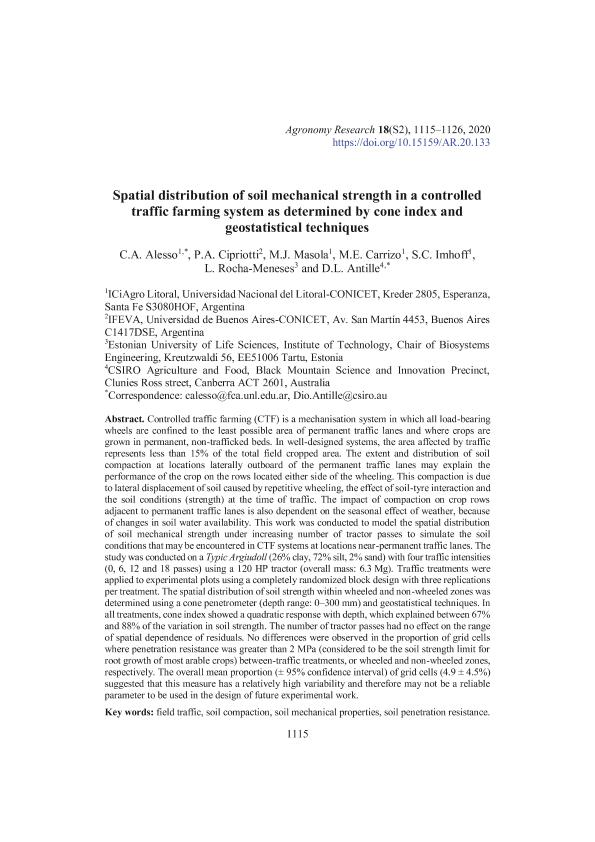Artículo
Spatial distribution of soil mechanical strength in a controlled traffic farming system as determined by cone index and geostatistical techniques
Alesso, Carlos Agustín ; Cipriotti, Pablo Ariel
; Cipriotti, Pablo Ariel ; Masola, María Josefina
; Masola, María Josefina ; Carrizo, Maria Eugenia
; Carrizo, Maria Eugenia ; Imhoff, Silvia del Carmen
; Imhoff, Silvia del Carmen ; Rocha Meneses, L.; Antille, D. L.
; Rocha Meneses, L.; Antille, D. L.
 ; Cipriotti, Pablo Ariel
; Cipriotti, Pablo Ariel ; Masola, María Josefina
; Masola, María Josefina ; Carrizo, Maria Eugenia
; Carrizo, Maria Eugenia ; Imhoff, Silvia del Carmen
; Imhoff, Silvia del Carmen ; Rocha Meneses, L.; Antille, D. L.
; Rocha Meneses, L.; Antille, D. L.
Fecha de publicación:
05/2020
Editorial:
Eesti Pollumajandusulikool
Revista:
Agronomy Research
ISSN:
1406-894X
Idioma:
Inglés
Tipo de recurso:
Artículo publicado
Clasificación temática:
Resumen
Controlled traffic farming (CTF) is a mechanisation system in which all load-bearing wheels are confined to the least possible area of permanent traffic lanes and where crops are grown in permanent, non-trafficked beds. In well-designed systems, the area affected by traffic represents less than 15% of the total field cropped area. The extent and distribution of soil compaction at locations laterally outboard of the permanent traffic lanes may explain the performance of the crop on the rows located either side of the wheeling. This compaction is due to lateral displacement of soil caused by repetitive wheeling, the effect of soil-tyre interaction and the soil conditions (strength) at the time of traffic. The impact of compaction on crop rows adjacent to permanent traffic lanes is also dependent on the seasonal effect of weather, because of changes in soil water availability. This work was conducted to model the spatial distribution of soil mechanical strength under increasing number of tractor passes to simulate the soil conditions that may be encountered in CTF systems at locations near-permanent traffic lanes. The study was conducted on a Typic Argiudoll (26% clay, 72% silt, 2% sand) with four traffic intensities (0, 6, 12 and 18 passes) using a 120 HP tractor (overall mass: 6.3 Mg). Traffic treatments were applied to experimental plots using a completely randomized block design with three replications per treatment. The spatial distribution of soil strength within wheeled and non-wheeled zones was determined using a cone penetrometer (depth range: 0–300 mm) and geostatistical techniques. In all treatments, cone index showed a quadratic response with depth, which explained between 67% and 88% of the variation in soil strength. The number of tractor passes had no effect on the range of spatial dependence of residuals. No differences were observed in the proportion of grid cells where penetration resistance was greater than 2 MPa (considered to be the soil strength limit for root growth of most arable crops) between-traffic treatments, or wheeled and non-wheeled zones, respectively. The overall mean proportion (± 95% confidence interval) of grid cells (4.9 ± 4.5%) suggested that this measure has a relatively high variability and therefore may not be a reliable parameter to be used in the design of future experimental work.
Archivos asociados
Licencia
Identificadores
Colecciones
Articulos (ICIAGRO-Litoral)
Articulos de INSTITUTO DE CIENCIAS AGROPECUARIAS DEL LITORAL
Articulos de INSTITUTO DE CIENCIAS AGROPECUARIAS DEL LITORAL
Articulos(CCT - SANTA FE)
Articulos de CTRO.CIENTIFICO TECNOL.CONICET - SANTA FE
Articulos de CTRO.CIENTIFICO TECNOL.CONICET - SANTA FE
Articulos(IFEVA)
Articulos de INST.D/INV.FISIOLOGICAS Y ECO.VINCULADAS A L/AGRIC
Articulos de INST.D/INV.FISIOLOGICAS Y ECO.VINCULADAS A L/AGRIC
Citación
Alesso, Carlos Agustín; Cipriotti, Pablo Ariel; Masola, María Josefina; Carrizo, Maria Eugenia; Imhoff, Silvia del Carmen; et al.; Spatial distribution of soil mechanical strength in a controlled traffic farming system as determined by cone index and geostatistical techniques; Eesti Pollumajandusulikool; Agronomy Research; 18; Special Issue 2; 5-2020; 1115-1126
Compartir
Altmétricas



